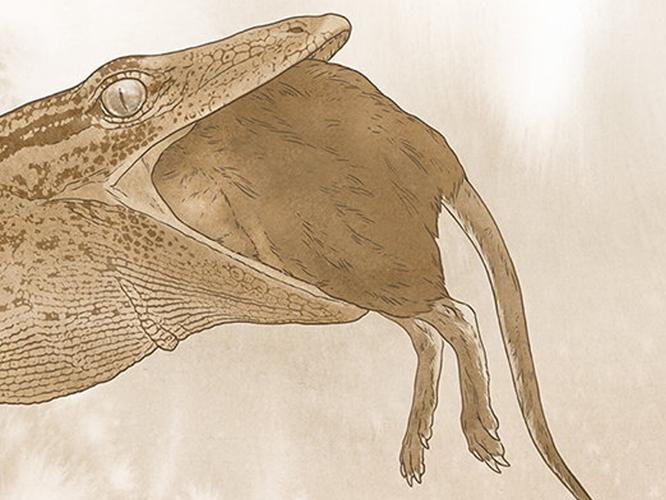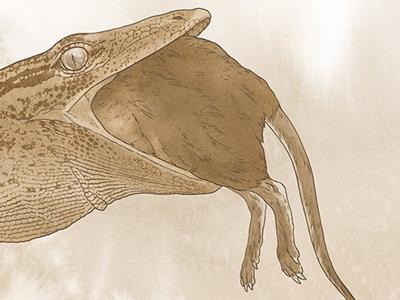
A reconstruction of Breugnathair elgolensis eating a mammal. (Mick Ellison / AMNH via SWNS)
By Stephen Beech
A "hook-toothed" reptile that lived in the Scottish Highlands around 167 million years ago fed on early mammals and young dinosaurs, say scientists.
The Jurassic predator - one of the oldest fossil lizards ever found - is linked to the origins of both snakes and geckos, according to new research.
It was given the Gaelic name Breugnathair elgolensis - meaning “false snake of Elgol” - referencing the area in the Isle of Skye where it was discovered in 2016.
Nearly 16 inches long from head to tail, scientists say Breugnathair was one of the largest lizards in its ecosystem, where researchers say it likely preyed on smaller lizards, early mammals, and other vertebrates, such as young dinosaurs.
It had snake-like jaws and hook-like, curved teeth similar to those of present-day pythons, along with the short body and fully-formed limbs of a lizard.
A multinational research team - including scientists from University College London (UCL), the National Museums Scotland and the American Museum of Natural History - described it in the journal Nature.
Study lead author Dr. Roger Benson, of the American Museum of Natural History, said: “Snakes are remarkable animals that evolved long, limbless bodies from lizard-like ancestors.

A reconstruction of Breugnathair elgolensis, the newly described Jurassic species with characteristics of both lizards and snakes. (Mick Ellison / AMNH via SWNS)
“Breugnathair has snake-like features of the teeth and jaws, but in other ways, it is surprisingly primitive.
"This might be telling us that snake ancestors were very different to what we expected, or it could instead be evidence that snake-like predatory habits evolved separately in a primitive, extinct group.”
Breugnathair was discovered in 2016 by Dr Stig Walsh, from the National Museums Scotland, while on an expedition with Dr. Benson on the Isle of Skye.
Researchers have spent almost 10 years since preparing the specimen, imaging it with computed tomography as well as with high-powered x-rays at the European Synchrotron Radiation Facility in Grenoble, France, and analysing the results.
They explained that lizards and snakes together form a group called squamates.
Breugnathair has been placed in a new group of extinct, predatory squamates called Parviraptoridae, which was previously known only from more fragmentary fossils.
Earlier studies reported snake-like tooth-bearing bones that were found near bones that had gecko-like features.
But because they seemed so drastically different, some researchers believed they belonged to two different animals.

A reconstruction of Breugnathair elgolensis. (National Museums Scotland / Bren via SWNS)
The new work on Breugnathair rejects those earlier findings, showing that both snake-like and gecko-like features exist together in a single animal.
Study co-leader Professor Susan Evans, of UCL, said: “The Jurassic fossil deposits on the Isle of Skye are of world importance for our understanding of the early evolution of many living groups, including lizards, which were beginning their diversification at around this time.
“I first described parviraptorids some 30 years ago based on more fragmentary material, so it’s a bit like finding the top of the jigsaw box many years after you puzzled out the original picture from a handful of pieces.
"The mosaic of primitive and specialized features we find in parviraptorids, as demonstrated by this new specimen, is an important reminder that evolutionary paths can be unpredictable.”
Because it has such an unusual mixture of features, and because other fossils that shed light on early squamate evolution are rare, researchers did not arrive at a conclusive answer whether is it a lizard-like ancestor of snakes.
They say another possibility is that Breugnathair could be a "stem-squamate" - a predecessor of all lizards and snakes, that independently evolved snake-like teeth and jaws.
Dr. Benson added: “This fossil gets us quite far, but it doesn’t get us all of the way.
“However, it makes us even more excited about the possibility of figuring out where snakes come from.”

























(0) comments
Welcome to the discussion.
Log In
Keep it Clean. Please avoid obscene, vulgar, lewd, racist or sexually-oriented language.
PLEASE TURN OFF YOUR CAPS LOCK.
Don't Threaten. Threats of harming another person will not be tolerated.
Be Truthful. Don't knowingly lie about anyone or anything.
Be Nice. No racism, sexism or any sort of -ism that is degrading to another person.
Be Proactive. Use the 'Report' link on each comment to let us know of abusive posts.
Share with Us. We'd love to hear eyewitness accounts, the history behind an article.